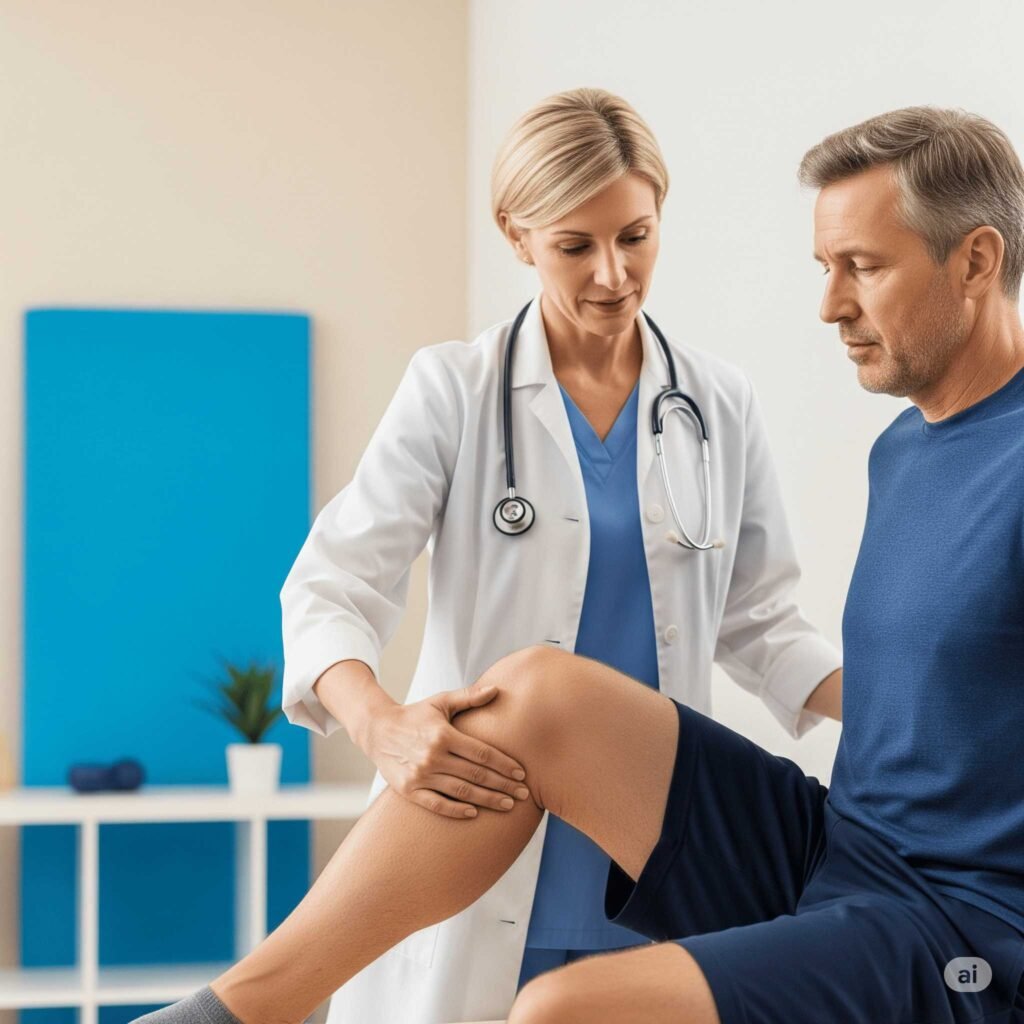Knee pain is one of the most common joint problems worldwide, affecting people of all ages — from teenagers involved in sports to older adults with arthritis. It can start suddenly after an injury or develop gradually over time due to wear and tear. If left untreated, knee pain can limit mobility, affect your work and daily activities, and even lead to long-term disability. Simple actions like walking, climbing stairs, or sitting down can become painful. This not only impacts your physical health but also your mental well-being.
Physiotherapy for knee pain is one of the safest and most effective treatments available. It targets the root cause of pain, strengthens the muscles around the knee, restores mobility, and prevents future problems. Unlike painkillers, which only mask discomfort, physiotherapy focuses on long-term recovery. In today’s digital age, physiotherapy online has made treatment even more accessible. Whether you live in a busy city or a remote area, expert physiotherapists can now guide you through personalised recovery programs from the comfort of your home.
This article will explore:
-
Causes and types of knee pain
-
How physiotherapy works
-
Key benefits of treatment
-
Best exercises for recovery
-
Role of online physiotherapy
-
Realistic recovery timelines
-
Why Resolve360 is a trusted provider
-
Practical tips to speed up healing
1. Understanding Knee Pain: Causes, Types, and Myths
1.1 Common Causes
-
Sports Injuries – Such as ACL tears, meniscus injuries, patellar dislocations.
-
Overuse – Runner’s knee, jumper’s knee, tendonitis.
-
Degenerative Conditions – Osteoarthritis, rheumatoid arthritis.
-
Trauma – Falls, accidents, or direct blows to the knee.
-
Surgery Aftercare – Knee replacement, arthroscopy, ligament reconstruction.
-
Muscle Weakness – Weak quadriceps or hamstrings causing instability.
1.2 Types of Pain
-
Acute – Sudden, sharp pain due to injury.
-
Chronic – Long-lasting pain from arthritis or old injuries.
-
Referred – Pain originating from hip, back, or nerve issues.
1.3 Myths vs Reality
-
Myth: Rest is the best solution.
Reality: Prolonged rest causes muscle weakness; guided activity aids recovery. -
Myth: Knee pain always needs surgery.
Reality: Many cases improve significantly with physiotherapy. -
Myth: Exercise worsens pain.
Reality: Correct, supervised exercises strengthen the joint and reduce discomfort.
2. How Physiotherapy for Knee Pain Works
Physiotherapy is a science-backed approach that addresses both the symptoms and underlying causes of knee pain.
2.1 Pain Relief
Therapists may use:
-
Ice or heat therapy.
-
Ultrasound or laser therapy.
-
TENS for nerve pain reduction.
-
Gentle joint mobilisation.
2.2 Strength and Stability
Strengthening key muscles such as the quadriceps, hamstrings, glutes, and calves provides better joint support.
2.3 Flexibility
Stretching restores the normal range of motion, preventing stiffness.
2.4 Manual Therapy
Includes massage, myofascial release, and mobilisation techniques to improve mobility.
2.5 Education
Patients learn correct movement patterns, posture, and activity modifications.
3. Benefits of Physiotherapy for Knee Pain
-
Faster recovery compared to rest alone.
-
Avoidance of unnecessary surgeries.
-
Increased joint stability.
-
Pain relief without long-term medication.
-
Long-term prevention of recurring problems.
With physiotherapy online, you can enjoy these benefits without frequent clinic visits.
4. Role of Physiotherapy Online
Physiotherapy online is a modern healthcare solution where patients receive treatment guidance through video calls, digital exercise programs, and remote progress monitoring.
Advantages:
-
Saves travel time.
-
Flexible appointment schedules.
-
Access to experienced therapists regardless of location.
-
Continued care during travel or relocation.
Resolve360 provides high-quality online physiotherapy services with personalised recovery plans, exercise videos, and regular progress tracking.
5. Best Physiotherapy Exercises for Knee Pain
Important: Always consult a physiotherapist before starting exercises.
5.1 Quadriceps Sets
-
Sit with your leg straight.
-
Tighten thigh muscles, press the knee down.
-
Hold 5 seconds; repeat 15 times.
5.2 Straight Leg Raises
-
Lie on your back, bend one knee, keep the other straight.
-
Lift the straight leg to knee height.
-
Hold 5 seconds; repeat 10–15 times.
5.3 Heel Slides
-
Lie on your back, knees bent.
-
Slide one heel forward, then back.
5.4 Hamstring Curls
-
Stand holding a chair.
-
Bend your knee to bring heel toward buttocks.
5.5 Step-Ups
-
Step onto a low platform, then step down.
-
Repeat with both legs.
6. Recovery Timeline
-
Mild strain: 2–4 weeks.
-
Moderate injury: 6–8 weeks.
-
Post-surgery: 3–6 months.
7. Why Choose Resolve360
Resolve360 offers:
-
Expert therapists.
-
Both in-person and online sessions.
-
Customised programs.
-
Regular progress reviews.
8. Tips to Speed Up Recovery
-
Follow your exercise plan consistently.
-
Avoid high-impact activities early in recovery.
-
Maintain a healthy weight.
-
Use supportive footwear.
-
Eat a balanced diet rich in anti-inflammatory foods.
Conclusion
Recovering from knee pain is not just about reducing discomfort — it’s about regaining your ability to live life without limitations. Physiotherapy for knee pain offers a complete solution that not only helps relieve pain but also addresses the root cause, strengthens your joints, and prevents future problems. One of the greatest advantages of physiotherapy is its personalised nature. Your treatment is tailored to your specific condition, goals, and lifestyle. This ensures faster results and long-term benefits. In the past, access to expert physiotherapy was limited to clinic visits. Now, with physiotherapy online, you can get professional guidance from the comfort of your home. This makes treatment more flexible, consistent, and accessible — no matter where you are.
If you’re ready to take the next step towards pain-free living, Resolve360 is here to help. With experienced therapists, customised programs, and a patient-focused approach, they provide everything you need for a smooth and effective recovery. Knee pain does not have to control your life. With the right guidance, dedication, and professional support, you can return to walking, running, and enjoying your daily activities without fear of pain or injury.







